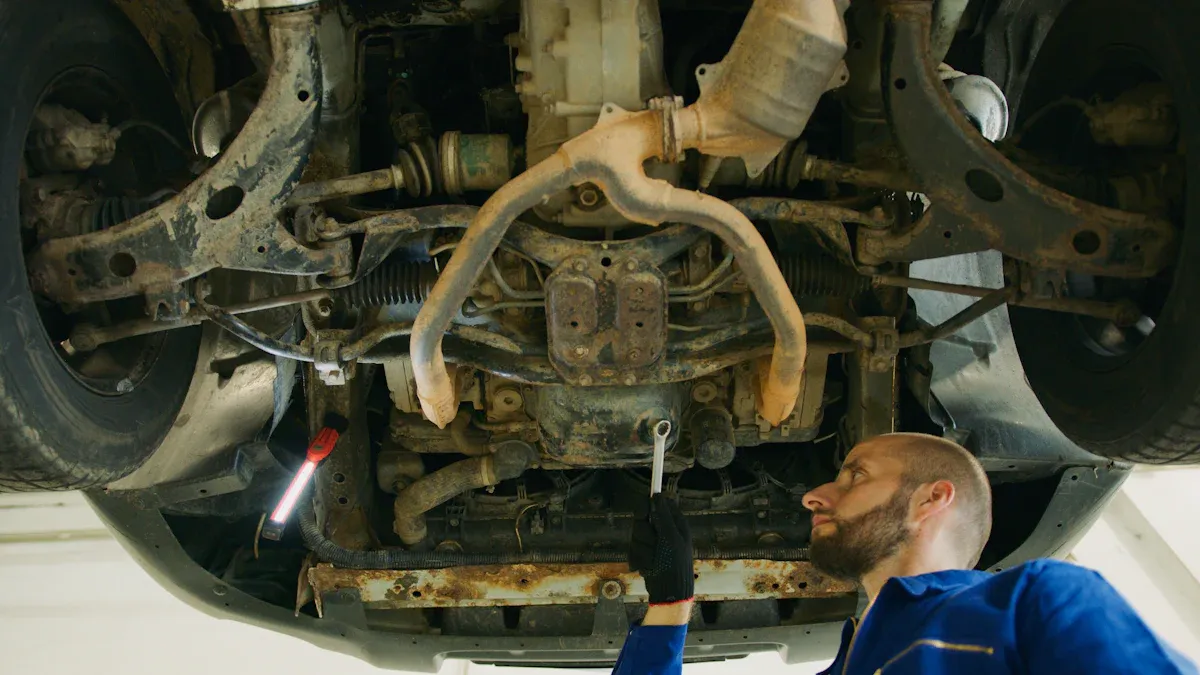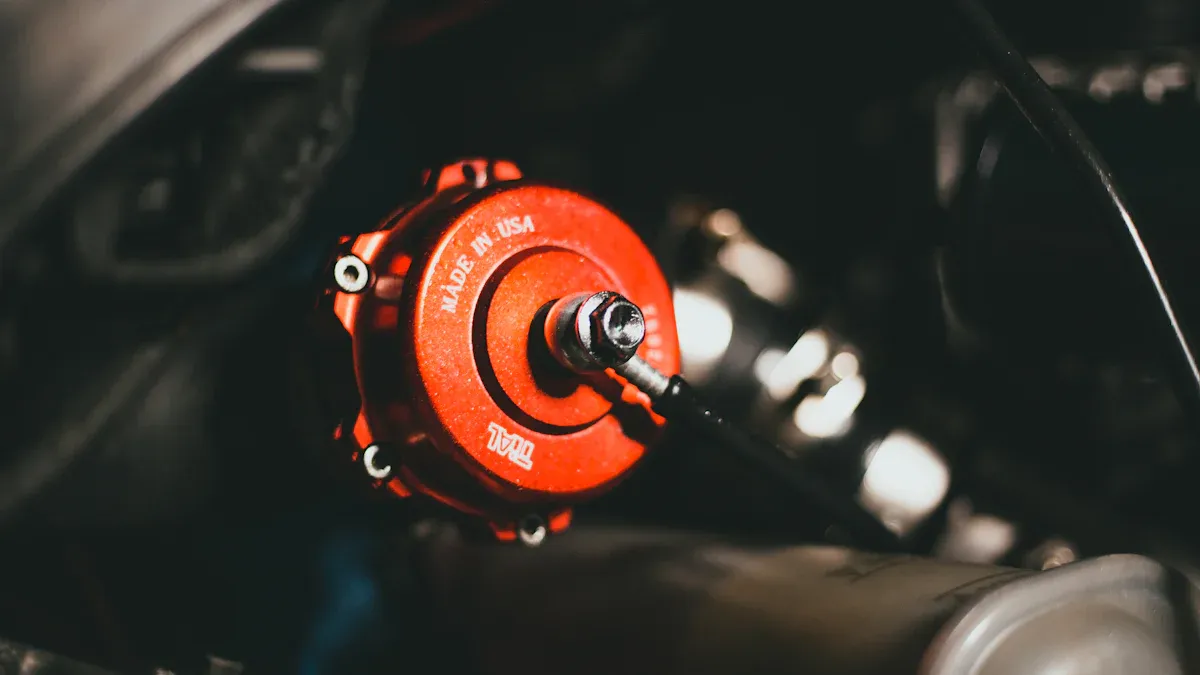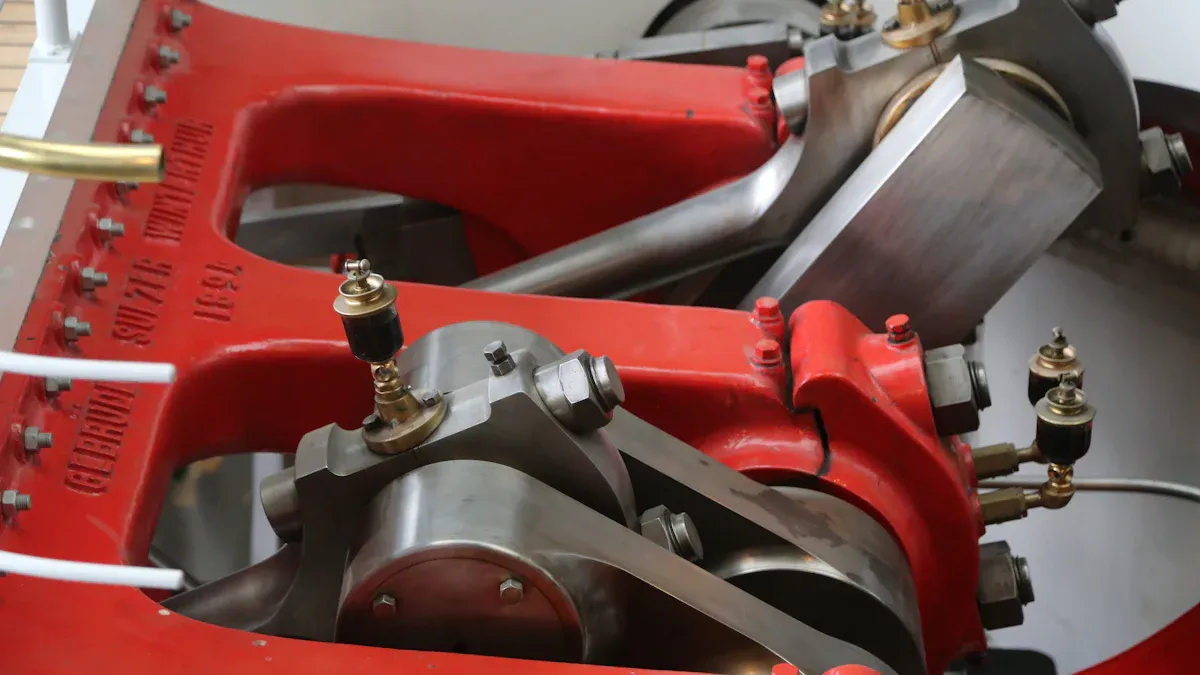
The clutch master cylinder helps you control your vehicle’s clutch system. It converts the force from your foot pressing the clutch pedal into hydraulic pressure. This pressure allows the clutch mechanism to engage or disengage smoothly. Without it, shifting gears would require much more effort and could lead to jerky movements.
Key Takeaways
- The clutch master cylinder changes foot pressure into hydraulic pressure. This helps your car shift gears smoothly.
- Problems with the clutch master cylinder include a soft pedal, hard gear shifting, and fluid leaks. Fix these quickly to avoid expensive repairs.
- Check fluid levels and look for leaks often. This can make your clutch master cylinder last longer and keep your car running better.
The Role and Importance of the Clutch Master Cylinder

How the clutch master cylinder works
The clutch master cylinder is a small but powerful hydraulic device. When you press the clutch pedal, it pushes a piston inside the cylinder. This action creates hydraulic pressure by compressing the fluid inside. The pressure travels through a hydraulic line to the clutch slave cylinder. The slave cylinder then uses this pressure to move the clutch fork, which engages or disengages the clutch. This entire process happens in seconds, allowing you to shift gears smoothly and efficiently.
The design of the clutch master cylinder ensures that the force from your foot is converted into precise hydraulic pressure. This precision is what makes modern vehicles easier to drive compared to older mechanical systems. Without this component, you would need to apply much more force to operate the clutch.
Why it is essential for clutch operation and gear shifting
The clutch master cylinder plays a critical role in your vehicle’s performance. It ensures that the clutch system operates smoothly, which is essential for seamless gear changes. If this component fails, you may experience difficulty shifting gears or even lose the ability to operate the clutch entirely.
A properly functioning clutch master cylinder also improves driving comfort. It reduces the effort needed to press the clutch pedal, making it easier for you to control the vehicle. Additionally, it helps prevent wear and tear on other clutch components by ensuring consistent hydraulic pressure. This not only extends the life of your clutch system but also enhances the overall safety and reliability of your vehicle.
Symptoms of a Failing Clutch Master Cylinder

Spongy or soft clutch pedal
A spongy or soft clutch pedal is one of the first signs of trouble. When you press the pedal, it may feel less firm than usual. This happens because air or moisture has entered the hydraulic system. The Clutch Master Cylinder relies on hydraulic pressure to work properly. If the pressure drops, the pedal loses its firmness. You might notice this change gradually or suddenly, depending on the severity of the issue.
Difficulty shifting gears
Struggling to shift gears often points to a problem with the hydraulic system. When the Clutch Master Cylinder fails, it cannot generate enough pressure to engage or disengage the clutch. This makes gear changes harder or even impossible. You may feel resistance when trying to move the gear stick or hear grinding noises. Ignoring this symptom can lead to further damage to the transmission.
Leaking hydraulic fluid
Leaking fluid is a clear sign of a failing Clutch Master Cylinder. Hydraulic fluid is essential for creating the pressure needed to operate the clutch. If you see fluid pooling under your car or notice the reservoir level dropping, inspect the system immediately. A leak not only affects performance but can also damage other components.
Clutch pedal sticking to the floor
A clutch pedal that sticks to the floor is a serious issue. This happens when the Clutch Master Cylinder cannot maintain hydraulic pressure. Without enough pressure, the pedal fails to return to its normal position. You may need to manually pull it back up, which is inconvenient and unsafe. Addressing this problem quickly can prevent further complications.
Diagnosing and Testing Clutch Master Cylinder Issues
Visual inspection for leaks or damage
Start by visually inspecting the Clutch Master Cylinder and its surrounding components. Look for any signs of hydraulic fluid leaks around the cylinder, the connecting lines, or the reservoir. Fluid leaks often appear as wet or oily spots, and they may collect under your vehicle. Check for cracks, corrosion, or other visible damage on the cylinder itself. Even small leaks can lead to a loss of hydraulic pressure, which affects the clutch’s performance. If you notice any damage, address it immediately to prevent further issues.
Checking hydraulic fluid levels
Next, check the hydraulic fluid levels in the reservoir. Locate the reservoir, usually near the firewall in the engine bay, and ensure the fluid level is within the recommended range. Low fluid levels can indicate a leak or excessive wear in the system. Use the correct type of hydraulic fluid specified in your vehicle’s manual. Contaminated or discolored fluid may also signal a problem. Replacing old fluid can help maintain the efficiency of the Clutch Master Cylinder.
Testing clutch pedal pressure
Finally, test the clutch pedal pressure. Press the pedal and observe how it feels. A healthy system should provide firm and consistent resistance. If the pedal feels spongy, soft, or sticks to the floor, it may indicate air in the hydraulic lines or a failing master cylinder. Pay attention to any unusual noises or vibrations during this test. These signs can help you identify potential issues early.
Repair vs. Replacement of a Clutch Master Cylinder
When to repair versus replace
Deciding whether to repair or replace the Clutch Master Cylinder depends on the severity of the issue. Minor problems, like small leaks or worn seals, can often be fixed with a repair kit. These kits include replacement seals and other components that restore the cylinder’s functionality. If the damage is limited to these parts, repairing is a cost-effective solution.
However, extensive damage may require a full replacement. Cracks in the cylinder body or severe corrosion cannot be repaired. These issues compromise the cylinder’s ability to maintain hydraulic pressure. Replacing the Clutch Master Cylinder ensures your clutch system works reliably and prevents further damage to other components. You should consult a mechanic to determine the best option based on the condition of your cylinder.
Tip: If your vehicle is older, replacing the cylinder might be a better choice. Newer parts often last longer and improve overall performance.
Cost considerations for repair and replacement
Repairing the Clutch Master Cylinder is usually less expensive than replacing it. A repair kit typically costs between $20 and $50, depending on your vehicle’s make and model. Labor costs for repairs are also lower since the process is less time-consuming.
Replacing the cylinder involves higher costs. A new Clutch Master Cylinder can range from $100 to $300, excluding labor. Installation costs vary based on your location and the complexity of the job. While replacement is pricier, it offers long-term reliability, especially for severely damaged cylinders.
Note: Weigh the costs against the benefits. Repairs save money upfront, but replacements may prevent recurring issues and additional expenses in the future.
Maintenance Tips for a Clutch Master Cylinder
Regularly check and replace hydraulic fluid
Keeping the hydraulic fluid in good condition is essential for the proper functioning of your Clutch Master Cylinder. Over time, the fluid can become contaminated with dirt or moisture, reducing its effectiveness. You should check the fluid level in the reservoir regularly. If it appears low or discolored, replace it with the type recommended in your vehicle’s manual. Fresh fluid ensures the hydraulic system maintains the pressure needed for smooth clutch operation.
Tip: Set a reminder to inspect the fluid every few months or during routine vehicle maintenance.
Inspect for leaks or wear
Leaks or worn-out components can lead to a failing Clutch Master Cylinder. Look for signs of hydraulic fluid around the cylinder, connecting lines, or under your vehicle. Even small leaks can cause significant problems over time. Check the cylinder and surrounding parts for cracks, corrosion, or other damage. Identifying these issues early can save you from costly repairs later.
Avoid excessive clutch use to reduce wear
Frequent or unnecessary use of the clutch can accelerate wear on the Clutch Master Cylinder. Avoid habits like riding the clutch pedal or keeping it pressed for extended periods. These actions increase pressure on the hydraulic system, leading to faster deterioration. Use the clutch only when necessary, and release it fully after shifting gears to prolong its lifespan.
Note: Practicing good driving habits not only protects the clutch system but also improves your vehicle’s overall performance.
The clutch master cylinder ensures smooth gear changes by maintaining hydraulic pressure in your vehicle’s clutch system. Recognizing early signs of failure, like leaks or a spongy pedal, helps you avoid costly repairs. Regular maintenance, such as checking fluid levels, extends its lifespan. Proper care improves your vehicle’s performance and keeps you safe on the road.
FAQ
What happens if you ignore a failing clutch master cylinder?
Ignoring a failing clutch master cylinder can lead to complete clutch failure. You may lose the ability to shift gears, which can leave your vehicle undrivable.
Tip: Address issues early to avoid costly repairs or breakdowns.
How often should you check the hydraulic fluid in the clutch system?
You should check the hydraulic fluid every few months or during routine maintenance. Regular checks help you spot leaks or contamination before they cause major problems.
Can you drive with a leaking clutch master cylinder?
Driving with a leaking clutch master cylinder is unsafe. The hydraulic pressure will drop, making it harder to shift gears. This can lead to sudden clutch failure while driving.
Note: Stop driving and fix the issue immediately to ensure safety.
Post time: Mar-28-2025

